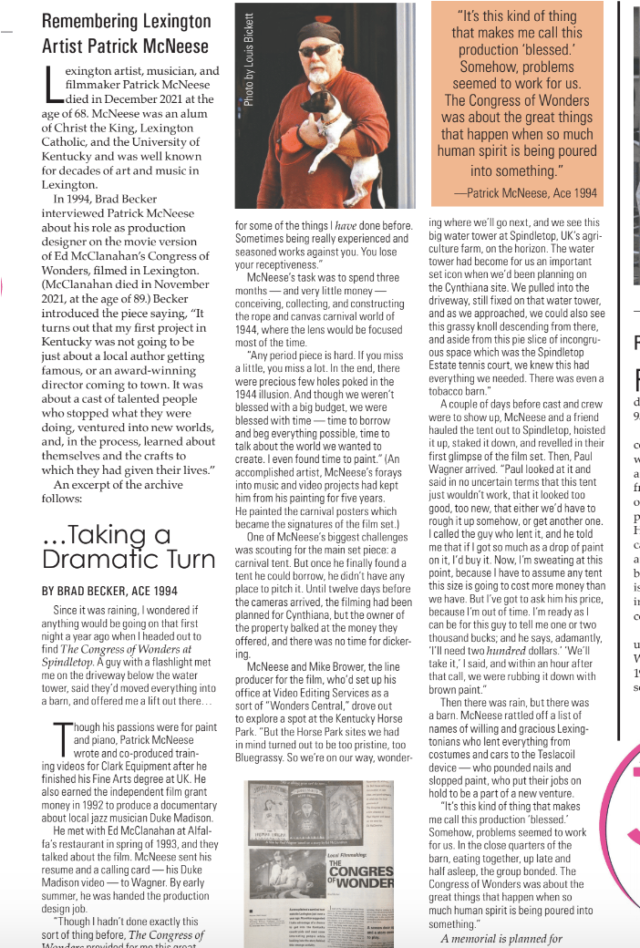Remembering Lexington Artist Patrick McNeese
Lexington artist, musician, and filmmaker Patrick McNeese died in December 2021 at the age of 68. McNeese was an alum of Christ the King, Lexington Catholic, and the University of Kentucky and was well known for decades of art and music in Lexington.

In 1994, Brad Becker interviewed Patrick McNeese about his role as production designer on the movie version of Ed McClanahan’s Congress of Wonders, filmed in Lexington. (McClanahan died in November 2021, at the age of 89.) Becker introduced the piece saying, “It turns out that my first project in Kentucky was not going to be just about a local author getting famous, or an award-winning director coming to town. It was about a cast of talented people who stopped what they were doing, ventured into new worlds, and, in the process, learned about themselves and the crafts to which they had given their lives.”
An excerpt of the archive follows:
…Taking a Dramatic Turn
Since it was raining, I wondered if anything would be going on that first night a year ago when I headed out to find The Congress of Wonders at Spindletop. A guy with a flashlight met me on the driveway below the water tower, said they’d moved everything into a barn, and offered me a lift out there…
Though his passions were for paint and piano, Patrick McNeese wrote and co-produced training videos for Clark Equipment after he finished his Fine Arts degree at UK. He also earned the independent film grant money in 1992 to produce a documentary about local jazz musician Duke Madison.
He met with Ed McClanahan at Alfalfa’s restaurant in spring of 1993, and they talked about the film. McNeese sent his resume and a calling card — his Duke Madison video — to Wagner. By early summer, he was handed the production design job.

McNeese’s task was to spend three months — and very little money — conceiving, collecting, and constructing the rope and canvas carnival world of 1944, where the lens would be focused most of the time.
“Any period piece is hard. If you miss a little, you miss a lot. In the end, there were precious few holes poked in the 1944 illusion. And though we weren’t blessed with a big budget, we were blessed with time — time to borrow and beg everything possible, time to talk about the world we wanted to create. I even found time to paint.” (An accomplished artist, McNeese’s forays into music and video projects had kept him from his painting for five years. He painted the carnival posters which became the signatures of the film set.)
One of McNeese’s biggest challenges was scouting for the main set piece: a carnival tent. But once he finally found a tent he could borrow, he didn’t have any place to pitch it. Until twelve days before the cameras arrived, the filming had been planned for Cynthiana, but the owner of the property balked at the money they offered, and there was no time for dickering.
McNeese and Mike Brower, the line producer for the film, who’d set up his office at Video Editing Services as a sort of “Wonders Central,” drove out to explore a spot at the Kentucky Horse Park. “But the Horse Park sites we had in mind turned out to be too pristine, too Bluegrassy. So we’re on our way, wondering where we’ll go next, and we see this big water tower at Spindletop, UK’s agriculture farm, on the horizon. The water tower had become for us an important set icon when we’d been planning on the Cynthiana site. We pulled into the driveway, still fixed on that water tower, and as we approached, we could also see this grassy knoll descending from there, and aside from this pie slice of incongruous space which was the Spindletop Estate tennis court, we knew this had everything we needed. There was even a tobacco barn.”
A couple of days before cast and crew were to show up, McNeese and a friend hauled the tent out to Spindletop, hoisted it up, staked it down, and revelled in their first glimpse of the film set. Then, Paul Wagner arrived. “Paul looked at it and said in no uncertain terms that this tent just wouldn’t work, that it looked too good, too new, that either we’d have to rough it up somehow, or get another one. I called the guy who lent it, and he told me that if I got so much as a drop of paint on it, I’d buy it. Now, I’m sweating at this point, because I have to assume any tent this size is going to cost more money than we have. But I’ve got to ask him his price, because I’m out of time. I’m ready as I can be for this guy to tell me one or two thousand bucks; and he says, adamantly, ‘I’ll need two hundred dollars.’ ‘We’ll take it,’ I said, and within an hour after that call, we were rubbing it down with brown paint.”
Then there was rain, but there was a barn. McNeese rattled off a list of names of willing and gracious Lexingtonians who lent everything from costumes and cars to the Teslacoil device — who pounded nails and slopped paint, who put their jobs on hold to be a part of a new venture.
“It’s this kind of thing that makes me call this production ‘blessed.’ Somehow, problems seemed to work for us. In the close quarters of the barn, eating together, up late and half asleep, the group bonded. The Congress of Wonders was about the great things that happen when so much human spirit is being poured into something.”
A memorial is planned for McNeese in the Spring.
This article appears on page 9 of the February 2022 print edition of Ace.






